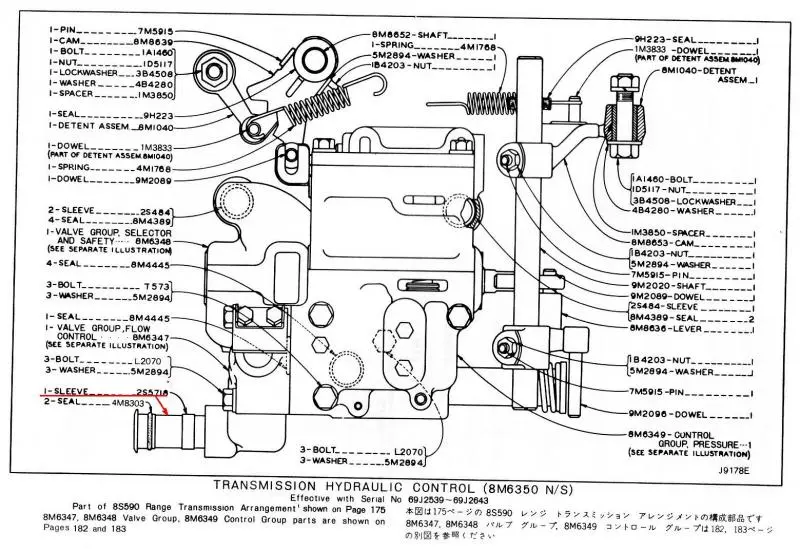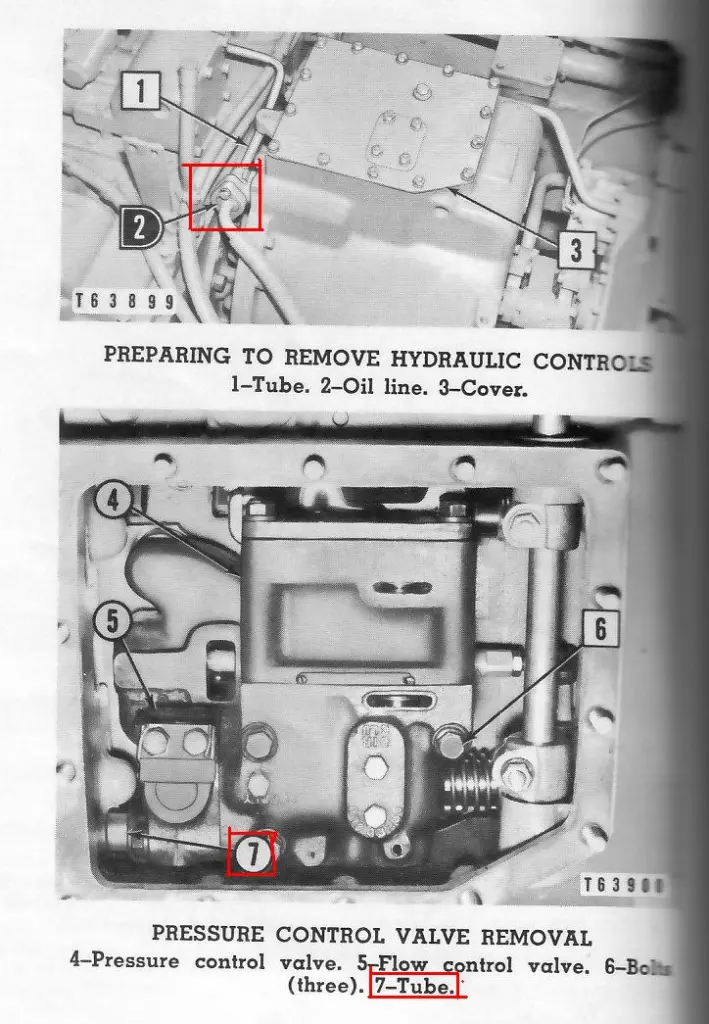Reply to OzDozer:
tnc110 - You could have a problem with your steering control valve (SCV). This is the valve unit that sits on top of the steering clutch/final drive case, underneath the fuel tank. You will see the steering linkages attached to it.
There are springs inside the SCV spools that give the resistance to the steering levers. If you have no steering lever resistance on the left side, you have a broken spring in the SCV.
The "grinding" sound may have been clutch plates slipping with low pressure. For the transmission to pop out of gear, this means you're losing transmission oil pressure.
The oil pressure is supplied to both the transmission and the steering clutches from the transmission oil pump. If you develop a leak anywhere in the system, this drops the pressure for both the transmission and the steering clutches.
The transmission control valve is operated by the gear lever and this valve needs oil pressure to compress a big spring to allow gear and direction selection.
If the oil pressure to the transmission control valve drops, the big spring comes into action, and returns the gear lever to neutral to prevent transmission damage.
Another thing that can happen is if your bevel gear bearings start to collapse (there is a taper roller bearing each side of the bevel gear), then the bevel gear shaft will drop, and this chews out the square, piston-ring type seal, in the actuating piston that disengages the steering clutch.
You will generally then lose the ability to disengage that particular clutch. However, it is unlikely you could lose drive to that side, unless the disengaging piston has jammed and is holding the steering clutch disengaged.
You can find out if you have failing bevel gear bearings by removing the thin plate that covers the PTO hole on the centre of the rear upright face of the steering clutch housing, inserting a crowbar under the bevel gear shaft and prying in an up-and-down motion. There should be no movement at all in the shaft. Serious amounts of movement indicate a failed bearing - and major back end repairs.
Of course, if a winch or any PTO-driven equipment is fitted, you will need to remove that, to access the bevel gear compartment.
Great info. Thank you!
[quote="OzDozer"]
tnc110 - You could have a problem with your steering control valve (SCV). This is the valve unit that sits on top of the steering clutch/final drive case, underneath the fuel tank. You will see the steering linkages attached to it.
There are springs inside the SCV spools that give the resistance to the steering levers. If you have no steering lever resistance on the left side, you have a broken spring in the SCV.
The "grinding" sound may have been clutch plates slipping with low pressure. For the transmission to pop out of gear, this means you're losing transmission oil pressure.
The oil pressure is supplied to both the transmission and the steering clutches from the transmission oil pump. If you develop a leak anywhere in the system, this drops the pressure for both the transmission and the steering clutches.
The transmission control valve is operated by the gear lever and this valve needs oil pressure to compress a big spring to allow gear and direction selection.
If the oil pressure to the transmission control valve drops, the big spring comes into action, and returns the gear lever to neutral to prevent transmission damage.
Another thing that can happen is if your bevel gear bearings start to collapse (there is a taper roller bearing each side of the bevel gear), then the bevel gear shaft will drop, and this chews out the square, piston-ring type seal, in the actuating piston that disengages the steering clutch.
You will generally then lose the ability to disengage that particular clutch. However, it is unlikely you could lose drive to that side, unless the disengaging piston has jammed and is holding the steering clutch disengaged.
You can find out if you have failing bevel gear bearings by removing the thin plate that covers the PTO hole on the centre of the rear upright face of the steering clutch housing, inserting a crowbar under the bevel gear shaft and prying in an up-and-down motion. There should be no movement at all in the shaft. Serious amounts of movement indicate a failed bearing - and major back end repairs.
Of course, if a winch or any PTO-driven equipment is fitted, you will need to remove that, to access the bevel gear compartment.[/quote]

